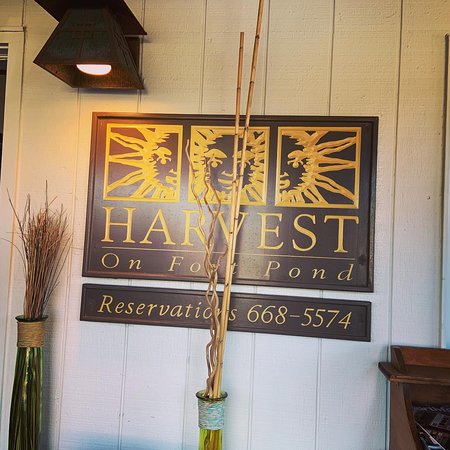Helene's Blog

A Tutor Can Make All the Difference
Does your child have Dyslexia or a Language-Based Disability?
Is your child failing in school?
Whether a child needs a helping hand to develop stronger study habits, sharpen his or her academic performance, or reduce anxiety and stress due to repeated academic failures, a tutor can make all the difference.
Dyslexia, a neurological, inherited condition caused by a different wiring of the brain, is not something a person can outgrow. It’s important to understand that dyslexia has no relationship to intelligence, but rather a condition where reading and writing become difficult to learn. Illiteracy isn’t about ignorant, brainless, lazy children. It’s about teachers using flawed reading methodologies that don’t work.
Reading is a superpower we all deserve.
The National Literacy Trust defines literacy as “the ability to read, write, speak and listen in a way that lets us communicate effectively and make sense of the world.” Being able to read and write, necessary skills for living a productive life with dignity and respect, represent freedom to live a life you’re meant to live.
Today, our country’s educational institutions are in crisis mode. Even before the pandemic, statistics from the U.S. Department of Education revealed that 20% of all public-school populations struggle with reading. That’s 1 in 5 kids that can’t read on grade level or can’t read at all. That is both statistically significant and an educational crime.
For a long time, universities and colleges ignored the cognitive science behind reading acquisition, offering instead flawed reading methodologies that didn’t work. It’s time our institutions of higher learning changed how they teach reading acquisition because illiteracy is a pipeline to prison. Almost 50% of the U.S. prison populations struggle with reading; 85% of juveniles in the court system are functionally illiterate; and two-thirds of kids who can’t read by the end of 4th grade will end up in jail or on welfare.
If your child struggles in school, personalized tutoring by a professional who understands the importance of using structured literacy in a direct, explicit, multi-sensory, sequential approach can reverse the repeated failures and traumas experienced in school, with the end goal of creating independent, self-confident learners.
It's never too late to seek a tutor who can change the trajectory of your child’s educational experience from low-self-esteem and failure to self-confidence and success in being an independent learner.

If You Plant Them, They Shall Come!
(Photo taken from Flowering Magazine Online Site)
Habitat loss is one of the greatest dangers to bees today. Overdevelopment of land, the high use of pesticides and toxic chemicals in our environment, diseases, and parasites have threatened the pollinators that provide us with most of our food. Creating habitats in our landscapes for native pollinators like "bees, flies, wasps, insects, moths, butterflies, beetles, bats, birds, and several mammals matter because without these pollinators, our fruits, vegetables, herbs, chocolates, coffees, nuts, and spices" will vanish off the face of the earth.
"There are over 20,000 bee species globally, four-thousands" of them beating their tiny wings in the United States alone, but their populations are dwindling at alarming rates. Anybody can create a bee habitat in a backyard garden or a flowerpot. By feeding the bees with "nectar and pollen rich" native perennials that bloom early in the season, followed by mid and late season blooms and avoiding the use of pesticides and toxic chemicals we can boost these dwindling pollinator populations. In the northeast, early blooming nectar and pollen rich flowers are Digitalis, Echinacea, Spiderwort, and Blue Wild Indigo. Mid-season blooming perennials are Milkweed, Wild Bergamot, Hyssop, Mountain Mint, and Blazing Star. These flowering plants can be followed by the late-season blooms of Goldenrod, Green-headed Coneflower, Yarrow, and New England Aster.
It’s never too late to plant your pollinator garden! If you plant it, they shall come!
Bibliography
- Flowering Magazine Online. Susan Hall Mahon. 2022. <https://flowermag.com/how-to-plant-a-pollinator-garden/>
- Northeast Pollinator Online. Ed. Jane Sorenson. 15 August 2023. <https://www.northeastpollinator.com/>
- The Spruce Online. Les Engles. 28 February 2022. < https://www.thespruce.com/all-about-pollinator-gardens-5195334>
- U.S. Department of Agriculture Online. Brianna Randall. 22 June 2020. <https://www.farmers.gov/blog/value-birds-and-bees#:~:text=More%20than%2080%20percent%20of,with%20the%20help%20of%20pollinators>

“The Seventh Generation”
“In our deliberation, we must consider the impact of our decisions on the next generations.” - From the Great Law of the Iroquois Confederacy
The people who made up the Iroquois Confederacy lived in the northern region of North America, specifically in the state of New York. The Six Nations were comprised of the Mohawks, the Oneidas, the Onondagas, the Cayugas, the Senecas, and the Tuscaroras. These people “created the oldest living participatory Democracy on Earth.”
Before the traditional Iroquois began a council meeting, they publicly declared, “In every deliberation we must consider the impact on the seventh generation…. even if it requires having skin as thick as the bark of a tree.” For the Iroquois, the generational make-up of their counsel embraced a far-reaching relationship between governmental leadership and respect for the environment. The rights of future generations never became an issue of policy because it was, instead, the very basis of their policies.
Conservation was the foundation upon which their culture was built. The first three sections of the Great Law begins as follows: “I (the Peacemaker), Hiawatha, and the Sachems have planted a tree of Peace….Under the shade of this great tree we have prepared seats for you….Should any nation or individual outside the Sachems adopt the Great Law upon learning them or by tracing their roots to the Great Tree….They will be made welcome to take shelter under the branches of this tree….We have tied ourselves together in one head, body, one spirit and one soul to settle all matter as one. We shall work, counsel, and confirm together for the future of coming generations.”
The people of the Iroquois Nation had been careful stewards of the Earth. Nowhere in that vast territory, the territory that is now known as New York State, was there a single polluted river, hazardous waste site, or open landfill. It’s time for people to adopt and live the ways of The Great Law, the Law of the Iroquois Nation.
MAKE A DIFFERENCE TODAY!
BE RESPONSIBLE. GET INVOLVED. BE PART OF THE SOLUTION!
Saving the planet is a joint effort. One of the most important steps in healing the planet is to learn about the environment. Then, and only then, will you be able to change the way you live on the Earth. Then, and only then, will you be equipped to influence your elected officials.
To bring about change, it’s necessary to contact government representatives and make your opinions known. As your delegate, they need to hear from you. How else will they be aware of their constituents’ feelings about different issues relating to the environment?
Support local and world-based environmental organizations whose goals are like yours. And, finally, be a “green consumer.” Buy recycled products, avoid items that use excessive packaging, and boycott products that harm the environment. Here are several ways you can become eco-friendly and start making lifestyle changes that can make a difference:
Save Energy: Remember to turn off lights when you leave a room, start using energy efficient light bulbs, turn off any appliances or machinery that are not in use, unplug your gadgets, use energy efficient appliances, adjust your thermostats, make small home improvements to better insulate your home, and support renewable energy.
Reduce, Reuse, Recycle: Recycle paper, aluminum, glass, and paper.
Use recycled products. Look for the recycling symbol on products you buy. Purchase bags that can be used repeatedly and avoid using plastic bags. Don’t litter. Start recycling in your home, school, and business. Boycott products that do not break down in the environment. Don’t buy foods that come in Styrofoam containers. Recycling reduces energy use. Conserve water at home. Check for water leaks. Drink less bottled water. Reduce household pollutants. Water plants and lawns in the evening.
Eat Healthy: Buy or grow organic fruits and vegetables. Buy products that are in season. Avoid foods that have been exposed to toxic pesticides, herbicides, and fungicides. Avoid eating species that have been overexploited. Minimize your food waste. Make low-impact food choices. Eat less junk food, such as sugary foods and sodas. Remember, you are what you eat.
Save the Forests: Boycott any wood products that contribute to the destruction of a tropical rainforest. Plant a tree - they absorb carbon dioxide and give off oxygen.
Don’t Waste Water: Water is a precious commodity. Don’t let the water run while you brush your teeth or wash your dishes. Flush the toilet only when it’s necessary. There is a saying that encourages water conservation: “If it’s yellow, let it mellow. If it’s brown, flush it down.”
What We Buy Affects Biodiversity: Buy what you need. Buy products that are made locally; less energy is used to transport these products. Choose products with minimal packaging. Avoid products that are made from endangered species. Look for durable products that will last for a long time. Buy products that have a low impact on the environment. Your consumer choices can make a difference to biodiversity conservation.
“Think globally! Act Locally!”
WHAT'S IN YOUR LAUNDRY DETERGENT?
The Poison in Your Laundry
In February of 2018, I posted an article I'd written for "Guestwords" in The East Hampton Star. As I walked through the lanes in East Hampton Village this morning, I couldn't get over all the toxic fragrances filling the streets during this pandemic. I hoped that the reason for it was due to the unavailability of so many healthy, free and clear, eco-friendly products, but I couldn't be sure, so I decided to post the article once again. Earth Day 2020 is Wednesday, April 22nd. Purchasing one of these healthier products could be one simple thing you could do to help eliminate pollution in the air, the soil, and the water.
Have you ever wondered what’s in that bottle of detergent or softener you pour into your washing machine, or on that fragrant dryer sheet you throw into your dryer? Well, it’s time you did, because the truth about your laundry products might make you change your laundry routine forever.
Many of the common laundry detergents, softeners, and dryer sheets that sit on our supermarket shelves, like Procter & Gamble’s popular original Tide, and fragrance-free Tide Free and Gentle, contain high levels of 1,4-dioxane, a carcinogenic pollutant. Lesser amounts of the same contaminant were detected in Bounce, both original and Free and Gentle. It’s no wonder that this carcinogenic contaminant has been found in 39 Long Island water districts, many of them in the Town of East Hampton. It’s a shame and a disgrace that Procter & Gamble has consciously chosen not to reformulate these toxic products that people use every day.
Neither New York State nor the federal Environmental Protection Agency regulates dioxane in drinking water. According to Citizens Campaign for the Environment, “Once this chemical flows down your drain, it travels into our groundwater through our septic tanks and cesspools,” before flowing “outward into our surface waters or downward into our aquifers, which are the sole source of Long Island’s drinking water. Removing it is a difficult problem once it hits the groundwater and soil.”
Not only is this toxic chemical found in laundry detergents and soaps, it’s also found in shampoos and body washes. Citizens Campaign for the Environment reports that “approximately 46 percent of personal care products, including detergents, dishwashing soaps, shampoos, cosmetics, deodorants, and body lotions, contain 1,4-dioxane.” In addition, dryer sheets, a common part of many people’s laundry routine, are laden with a multitude of toxic ingredients.
Why would you expose your skin to such dangerous contaminants? If you look on the box of those dryer sheets, you’ll discover that none of the toxic ingredients are listed. Why not, you ask? Well, the current U.S. Consumer Product Safety Commission doesn’t require it.
Dr. Anne Steinemann, an expert on pollutants and human health at the University of Melbourne in Australia, has studied the chemicals that discharge from people’s dryer vents into the air and then into our lungs and found that “there are seven dangerous air contaminants and 25 volatile organic compounds that are emitted into the air from fabric softeners and dryer sheets, such as acetaldehyde and benzene. These contaminants are not safe at any level; they are the same pollutants that are emitted from the tailpipes of automobiles. Acetaldehyde is a common ingredient used in fake fragrance blends. It’s potentially carcinogenic to humans and adversely impacts the kidneys and nervous and respiratory systems.”
Just take a bike ride or a walk through any neighborhood, as I did this morning, and you can smell these noxious chemicals being blown out of your neighbors’ dryer vents.
In 2016, Dr. Steinemann conducted a study that found that “12.5 percent of people blamed scented laundry products spewing from dryer vents for health issues. These included migraines, respiratory issues, skin issues, asthma attacks, and gastrointestinal symptoms.” The scary thing is that Procter & Gamble, the company responsible for most of these products, touts them as being “ideal for newborns and babies.”
What can you do? Stop buying these contaminated products. Each of us as individuals, working together as a community of concerned citizens, can make a difference. All you need to do is say no to the use of these products and purchase eco-friendly detergents instead. There are several companies, such as Seventh Generation, that have come out with healthy, effective cleaning and laundry products.
In addition, the not-for-profit organization Earthjustice recently asked residents of New York to contact Gov. Andrew Cuomo because “he promised to make protecting the public and the environment from chemical contamination a top priority.” I realize that our governor has had his hands full as he works tirelessly for New Yorkers during this social distancing, sheltering pandemic, but for your health, and the health of the environment, “tell Governor Cuomo to require disclosure of all cleaning product ingredients — not just those products the manufacturers add intentionally.”
We should be holding the governor to his promise. Let him know who you are, where you live, and that you’d like transparency for everything that’s being put into cleaning products, shampoos, and body washes that are being sold in New York State.
Remember, it’s never too late to take a stand for your health and for the health of our environment.
Helene Forst is a teacher, environmental activist, and the author of two young-adult novels, “The Journey of Hannah Woods” and “Stoked — 1969.” She lives in East Hampton.
EARTH DAY 2020
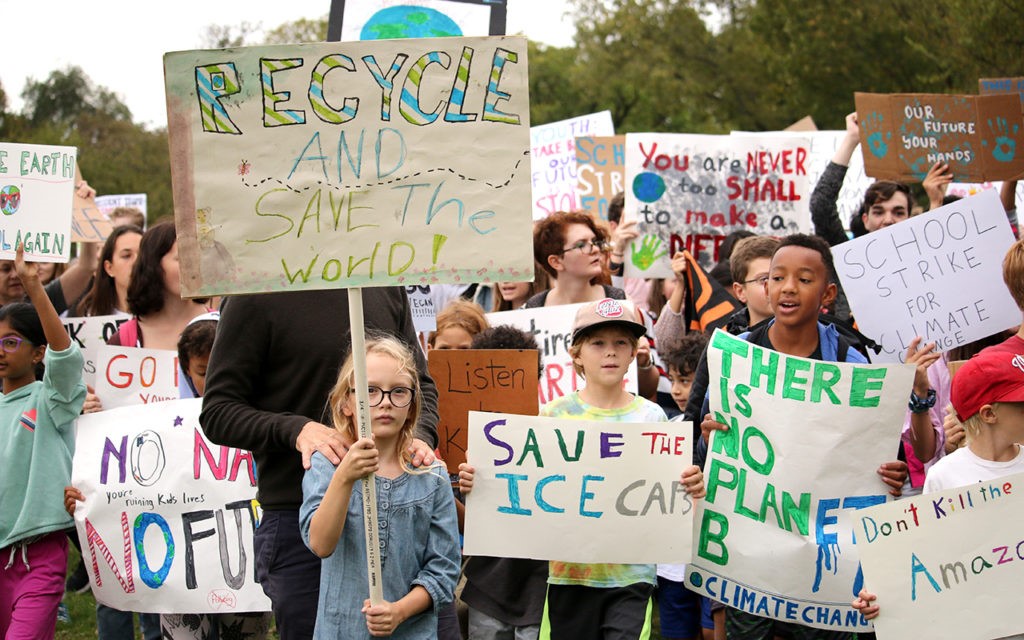
The first Earth Day took place fifty years ago on April 22nd, 1970, launching a wave of action, including the passage of landmark environmental laws in the United States, including: The Clean Air Act, The Clean Water and Endangered Species Acts, and the creation of the Environmental Protection Agency (EPA). It mobilized millions of Americans for the protection of the planet. On that day, 20 million Americans, that's 10% of the population of the United states at that time, took to the streets, college campuses, and hundreds of cities to protest environmental ignorance and demand a new way forward for our planet.
Internationally, Earth Day continues to hold major significance when in 2016 the United Nations chose Earth Day as the day when the historic Paris Agreement on climate change was signed into force.
Thanks to heroic actions around the world during this global pandemic, we will overcome and recover from the Coronavirus. Life will return to a new normal, but we must not allow the return to business as usual because our planet, our future, depends on it.

The theme for Earth Day 2020 is climate action, because climate change represents the biggest challenge to the future of humanity and the life-support systems that make our world habitable.
There is so much we can all do. The world needs all of us, all our actions to help protect and restore our planet, making every day Earth Day.
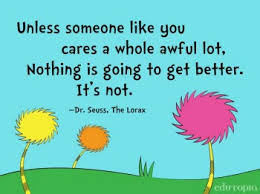
Despite decades of environmental progress, we still find ourselves facing a tipping point of global environmental challenges, from plastic pollution, biodiversity, air, soil, and water pollution, and rising seas.
No matter where you are, you can make a difference, building a new generation of environmental activists, right from your home while social distancing and protecting your community. Here are a few ideas where you can exercise your responsibility to act for the environment.
For Earth Day's 50th anniversary, use these ideas to inspire meaningful actions, actions that can and should be turned into habits that last beyond April 22nd, for we must remember that Every Day Is Earth Day!
Plastic Pollution - Plastics have become a huge part of our daily lives, but you can make a difference by changing what you buy and how you get rid of plastics. Walk around your home and count how many plastic containers, bags, and bottles are in your kitchen and bathroom. Research more sustainable packaging for the next time you order online or grocery shop. When you order takeout from a restaurant, ask them to skip the plastic utensils. Every little bit helps.
Food and Climate - Learn about the impacts of your food choices and research cooking recipes that are plant-based alternatives. Live stream a plant-based cooking class, or how to preserve through canning, pickling, drying, and freezing to enjoy fruits and vegetables year-round to minimize your food waste. If you are able, volunteer or donate to assist local food pantries in your community. We can fight climate change with the change in our diets.
Artists in the Environment - Art is a powerful tool to communicate messages, trigger emotions, and inspire action. Perhaps you can create an art project that will inspire people to realize the climate challenges we are all facing. Some suggestions: Gather nature items from outside like pinecones and leaves, acorns or pressed spring flowers and design an art project out of them. What animals can you create out of the things you find? Perhaps you could draw or sketch or paint a picture of what a sustainable future might look like to you. Writing a creative story about what that world might look like to you can add another dimension to your picture.You might repurpose materials from around your home, making new items like jewelry or plant holders. The sky is the limit!
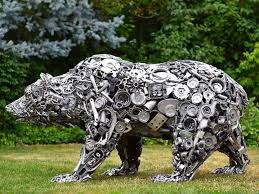


Protecting Our Species - Watch an environmental documentary and research ways to protect endangered animals in their natural habitats, or research what pollinators are native to your area and what plants they rely on. Perhaps you could design a pollinator garden this spring for your yard. It's never too late to learn about the impacts of biodiversity loss and how to help mitigate its negative impacts.

APRIL'S "SUPER PINK MOON"
April Full Moon 2020: "Super Pink Moon," the biggest of the year, rises Tuesday

The full moon of April 2020, called the "Super Pink Moon," a cosmic distraction from COVID-19, will occur on Tuesday, April 7th. Skywatchers in the U.S. can see the "Super Pink Moon" rise into the evening sky as the sun sets on Tuesday. For those who don't know, a "supermoon" is a full moon that appears slightly larger than average. In New York City, moonrise is at 7:05 p.m. local time on the evening of April 7th, and moonset is the next morning at 7:05 a.m.
The Pink Moon, which really isn't pink, symbolizes the sprouting of seed and the explosion of pink flowers – the moss pink, or the wild ground phlox, one of the first flowers to bloom with the arrival of the spring. According to The Old Farmer's Almanac, it can also appear to be red-orange due to the composition of Earth's atmosphere and the angle at which it is viewed. April's Full Moon has also been called the Sprouting Grass Moon, the Egg Moon, and the Fish Moon.
The Native American Full Moon names, relating to nature, the seasons, hunting, fishing, and farming, date back to when Native Americans lived in today’s northern and eastern United States. They reflect the harsh climate of North America and the lifestyle traditions of its first people.
The Algonquin Full Moon names, and variations used by other Native American tribes, are descriptive of nature’s seasons and gifts. The indigenous people kept track of the seasons by giving distinctive names to each recurring Full Moon.
For the Abenaki, the April Full Moon was the “Sugar Maker Moon.” For the Arapaho, it was called the “Ice Breaking In The River Moon.” The Cheyenne called it the “Moon When The Geese Lay Eggs.” The Cree of the Northern Plains and Canada referred to the April moon as the “Gray Goose Moon." And for the Tlingit of the Pacific Northwest, the April full moon was known as the "Budding Moon of Plants and Shrubs."
In this time of the pandemic, if possible to get outside while respecting social distancing, breathe in the energy of this uplifting "supermoon," and listen to the wisdom plants and animals have to impart. Know that these dark days of the "world on pause" will pass. Life as we know it may be different, but each day we are alive is a day to give thanks. As Clint Eastwood once said, it's time to improvise, overcome, and adapt.
DYSLEXIA AWARENESS DAY

On Wednesday, March 4th, 2020, students, parents, advocates, and experts from across the state will gather at the New York State Capitol in Albany for this extraordinary event to network with others, meet with legislators to share their experiences, and advocate for solutions, such as early screening (A5259 Simon / S4341 Brooks), teacher training (A6450 Simon / S4342 Brooks), a dyslexia task force (A8786 Carroll / S7093 Hoylman), and require schools to provide interventions and special curricula for children with dyslexia (A7210 Carroll / S5608 Jackson).
The keynote speaker will be Ameer Baraka, who was diagnosed with dyslexia while he was in jail. He learned to read, and is now a thriving activist, actor, and producer who has partnered with Assembly member Jo Anne Simon on dyslexia advocacy. People who are in prison and people of color have a higher rate of undiagnosed dyslexia. Ms. Simon's bill (A7822 Simon / S6787 Myrie) would require that people who are incarcerated who do not have a high school diploma or GED are screened for being at risk for dyslexia.
Support the right to read for all, it's the only right thing to do!
The Cold Moon
Historically, Native Americans named each full moon as a way to track the seasons. The next full moon will occur on December 12th and is known as the Cold Moon or the Long Night Moon. In Europe, this moon is often referred to as the Moon before Yule. Yule is an old northern European winter festival that is now associated with Christmas and the winter holiday season. The Long Night Moon gets its name because the full moon in December occurs near the winter solstice, which has the longest night of the year. This full moon sits above the horizon for a long period of time as the winter cold fastens its grip, and the nights become long and dark. Each full Moon names were applied to the entire month in which each occurred.

Whether you celebrate Christmas, Chanukah, Yule, or Kwanza, it's a time of peace and friendship to all mankind and to the creatures that inhabit the earth. As the ground is starting to freeze and food is getting scarce, it becomes a great time to fill your bird feeders.
Allow yourself time to rest and repair. But also allow yourself time to celebrate and share.
Remember, the best time to observe a full moon isn’t when it’s bright, white, and high in the night sky, but rather when it's close to the horizon as it rises and sets. Nature speaks to us continuously if we take the time to observe it and be one with it. The reward of the Cold Moon will drench you in the beauty of this chilly, snow white season.

SURF MOVIE NIGHT 17: A BENEFIT FOR CLEAN WATER AND HEALTHY BEACHES

"The Surfrider Foundation Eastern Long Island Chapter announces Surf Movie Night XVII at Guild Hall, 158 Main Street, East Hampton, on Wednesday, July 31 at 7:00 p.m. Proceeds from the evening will benefit the Surfrider Foundation Eastern Long Island Chapter's Clean Water Programs including Ocean Friendly Gardens, Rise Above Plastics, and the Blue Water Task Force water quality-monitoring program which tests and reports on 50 local beach and freshwater sampling sites. The program provides critical data to residents and decision-makers to inform on health and safety issues pertaining to bacteria and other contaminants. "
"Surfrider Foundation Eastern Long Island Chapter (SFELI) is dedicated to the protection of our oceans, waves, and beaches. The chapter has been a strong advocate of public access and environmental preservation along our shoreline from Montauk Point to Moriches Inlet for over 15 years. Staffed almost entirely by a dedicated team of volunteers, the grassroots chapter has worked, and continues to work, with every level of government on resolving important coastal issues including shore preservation, sea level rise, beach access and water quality. In addition, dozens of beach cleanups, educational programs, and dune plantings have been done with local students and community members."
EAST HAMPTON VOLUNTEER OCEAN RESCUE WATER SAFETY/HANDS-ONLY CPR TRAINING
On Saturday, June 1st, 2019, members of East Hampton Volunteer Ocean Rescue conducted a free-of-charge Water Safety/Hands-Only CPR Training at the East Hampton Library in the Baldwin Family Lecture Room.


WATER SAFETY TIPS
In any suspected emergency always call 9-1-1 immediately. Stay on the phone until Dispatch has all the necessary information. Dispatch will activate the appropriate emergency resources - Police, Fire, Ambulance, Marine Patrol, Coast Guard, and/or Ocean Rescue.
THE GRIM STATISTICS
350 kids under the age of five drown in pools each year nationwide. In this age group, drowning is the second leading cause of death after motor vehicle accidents. Most children were being watched by their parents or caregivers and most accidents happened quickly.
Child Drowning is a silent death.

RULES FOR POOLS
Always instruct your babysitters about potential pool hazards. Those supervising children should not be distracted by phones, books, conversations, or homework. Never leave a child unsupervised by a pool. Remove toys from pool when not in use. Never leave a gate open.
Learn CPR.
When having a pool or beach party - hire a lifeguard! A designated pool watcher is NOT a substitute for a trained lifeguard.
BARRIER PREVENTION AND POOL, FENCE AND DOOR ALARMS
Many communities have enacted safety regulations governing residential swimming pools; it's up to parents to comply with these regulations. Apart from these laws, parents who own pools can take additional precautions to reduce the chances of their youngsters accessing the family pool or spa without adult supervision. Remember: Barriers are not childproof, but they do provide layers of protection for a child who strays from supervision. Barriers give parents additional time to locate a child before the unexpected becomes a reality.
RIP CURRENT SURVIVAL TIPS
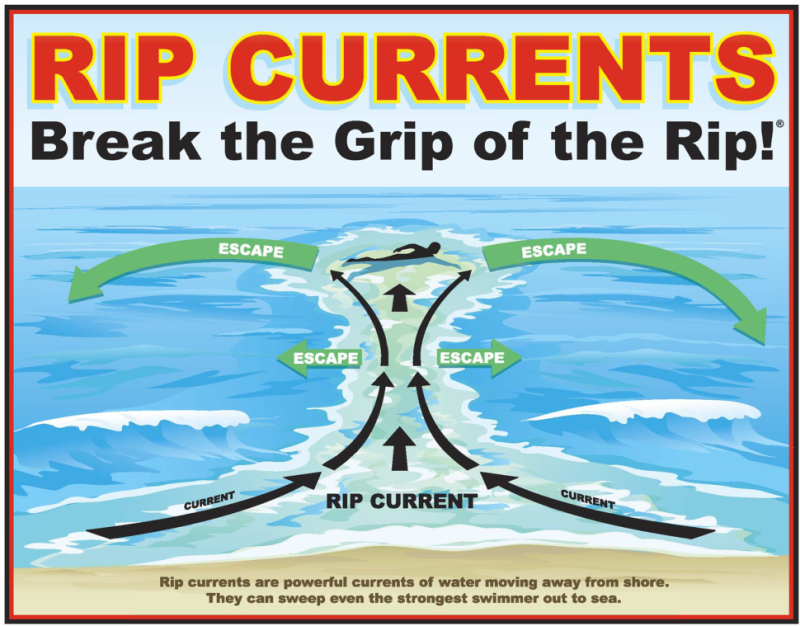
According to the United States Lifeguarding Association, "rip currents are the greatest hazard to swimmers on surf beaches."
If possible, swim near a lifeguard. If you are in trouble, shout and wave; circle one arm up with a closed fist for help. Never swim alone and be cautious at all times.
If in doubt, don't go out!
If caught in a rip, remain calm to conserve energy and think clearly. Don't fight the current. Swim parallel to the shoreline. If unable to swim out of the rip current, float or calmly tread water. When out of the current, swim toward shore.

"WHEN THUNDER ROARS, GO INDOORS!"
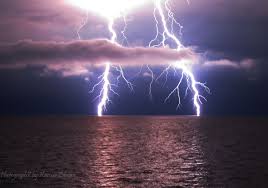
As a rule, lightning occurs most frequently within 10 miles of a thunderstorm, but bolts of lightning can travel as far as 20 miles from the storm. Stop all outside activities and seek shelter in a solid building or hard-topped vehicle.
Wait 30 minutes after the storm to resume activities. Beaches and bodies of water do not offer protection from lightning.
BOAT WATER SAFETY

Always wear your Personal Flotation Device (PDF). If you capsize, remain with your boat and call for help. Always dress for the water temperature. Swim-test your gear every time you go out. Imagine the worst that could happen and plan for it.
East Hampton Main Beach Lifeguard Tournament
Place: Main Beach, East Hampton, New York
Date: Thursday, July 25, 2019
Time: 4:00 p.m.
East Hampton Ocean Rescue Scholarship Benefit
East Hampton Volunteer Ocean Rescue's Scholarship Benefit to be held at the Harvest Restaurant in Montauk, New York, on Tuesday, July 9, 2019, starting at 5:00 p.m.




